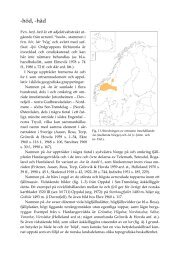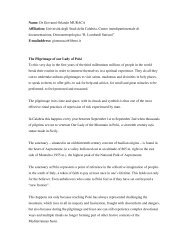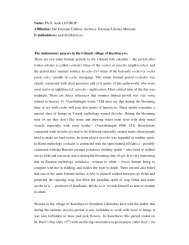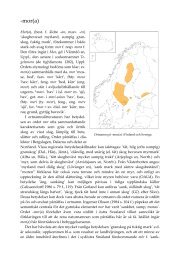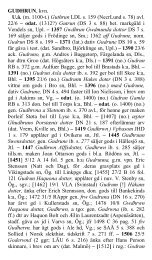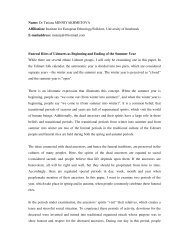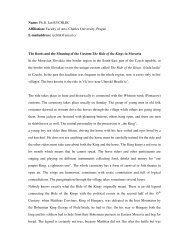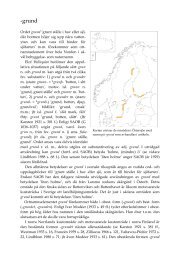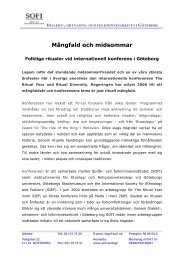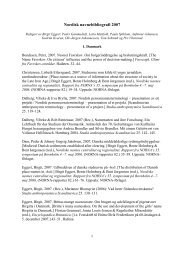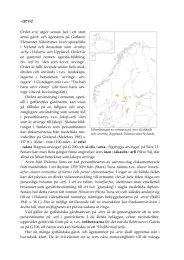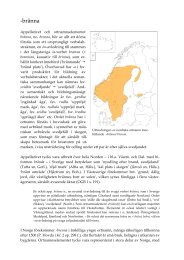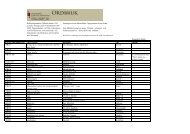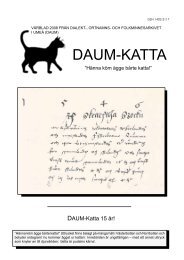NORNA-RAPPORTER 88 Binamn. Uppkomst, bildning, terminologi ...
NORNA-RAPPORTER 88 Binamn. Uppkomst, bildning, terminologi ...
NORNA-RAPPORTER 88 Binamn. Uppkomst, bildning, terminologi ...
Create successful ePaper yourself
Turn your PDF publications into a flip-book with our unique Google optimized e-Paper software.
28 Bertie Neethling<br />
In all these bestowed bynames, the name giver has identified an identity aspect,<br />
no matter how small and insignificant, that adds to the total makeup of the<br />
name carrier. It may then be a combination of positive and negative features.<br />
Felecan (2009) even suggests that nicknaming is, most of the time, a subversive<br />
act, and the name carrier is often oblivious of these nicknames. That might be<br />
so in certain cases, but one should also stress the fact that the name carrier is<br />
best situated to recall or know all the bynames used to refer to him/her. Hence<br />
the method of selfreporting questionnaires remains likely to be the best way of<br />
collecting information on bynames. It is equally important to realise that many<br />
of these bynames may not have a formal written (down) tradition, i.e. are only<br />
used in speech. As such, their representation or spelling remains arbitrary and<br />
entirely in the hands of the name carrier who reports on them. These representations<br />
as presented in the questionnaires have simply been accepted at face<br />
value. The users of these bynames may have preferred different spellings.<br />
Data on bynames<br />
The type of additional, byname or nickname represented in the questionnaires<br />
is of an astonishing variety, and it would probably be futile to attempt some sort<br />
of classification, no matter what criteria one applies as a yardstick. There is often<br />
no relationship or derivational connection whatsoever between any ‘formal’<br />
given name and the additional name (see also Landman 1986). The<br />
circumstances giving rise to the formation and usage of such additional names,<br />
are so varied that it is extremely difficult to organise the data in a meaningful<br />
way. Although respondents were asked to elaborate on how and why these additional<br />
names were bestowed, many did not supply any meaningful explanation<br />
or detail, and one is left to one’s own conjecture. Many appear to be the<br />
‘whim’ of an individual with no obvious strong motivation behind the choice.<br />
Many scholars have previously commented on the morphology of first names.<br />
De Stadler (1985:20) mentions that proper names are morphologically speaking<br />
‘loose’ because so many are added daily to the onomasticon and the need<br />
for new creations is great. Van Langendonck also refers to the ‘arbitrary and<br />
instable character of its shape’ (1982:57). This ‘looseness’ or ‘arbitrariness’ is<br />
simply compounded in the bynames. De Klerk and Bosch (1997:95) argue that<br />
‘Such names offer a rare example of people using language creatively in accordance<br />
with a logic that is not laid down from outside; they are a means of<br />
displaying linguistic licence, of breaking rules freely, and getting away with it.’<br />
If one, however, starts off from a derivational and/or morphological viewpoint<br />
(internal), one can identify a specific typology. Some of these will now<br />
be highlighted.<br />
A common probably universal category is strongly represented in the data,<br />
and that is the so-called ‘shorter’ or abbreviated form of the formal given name.<br />
This appears to be common all across the world. Particularly longer first names<br />
in any language or culture group are subject to shortening, simply to facilitate



